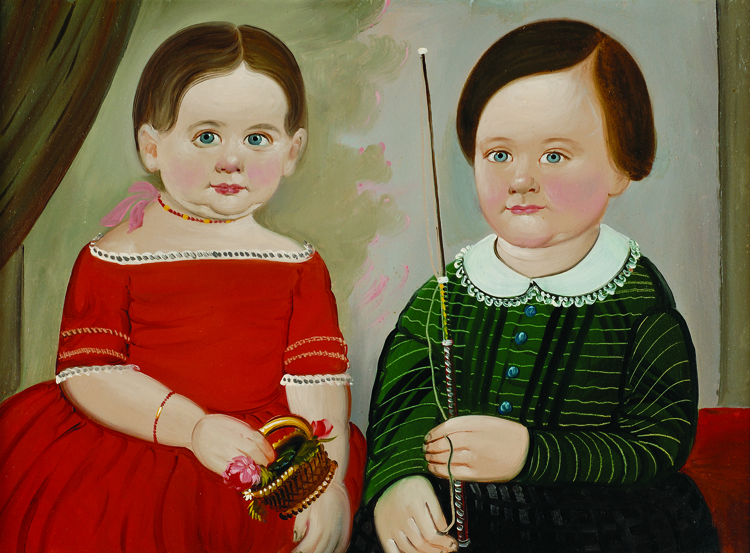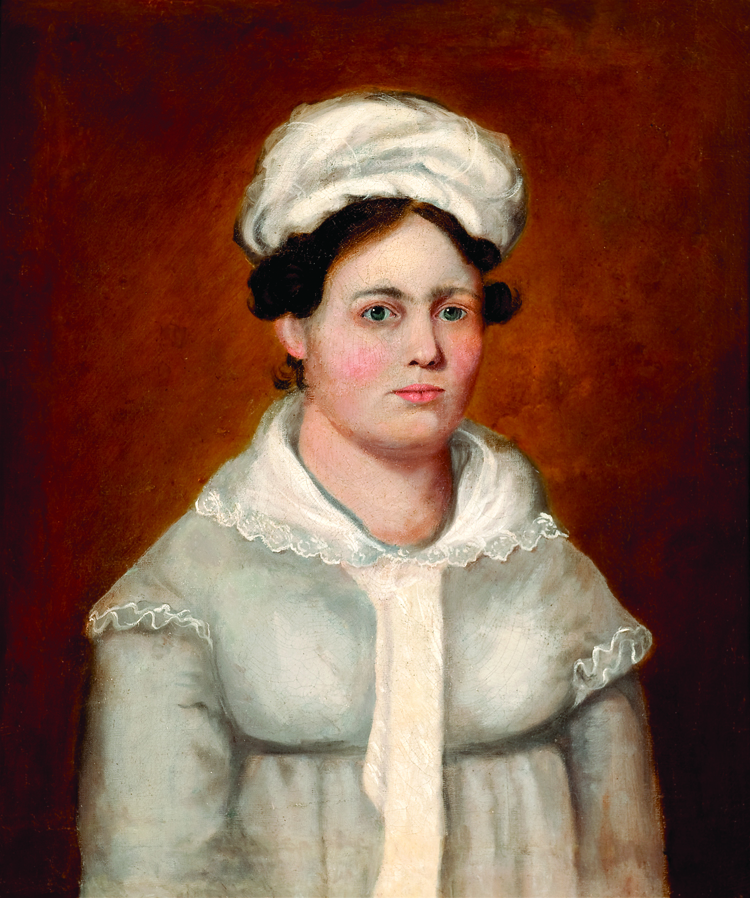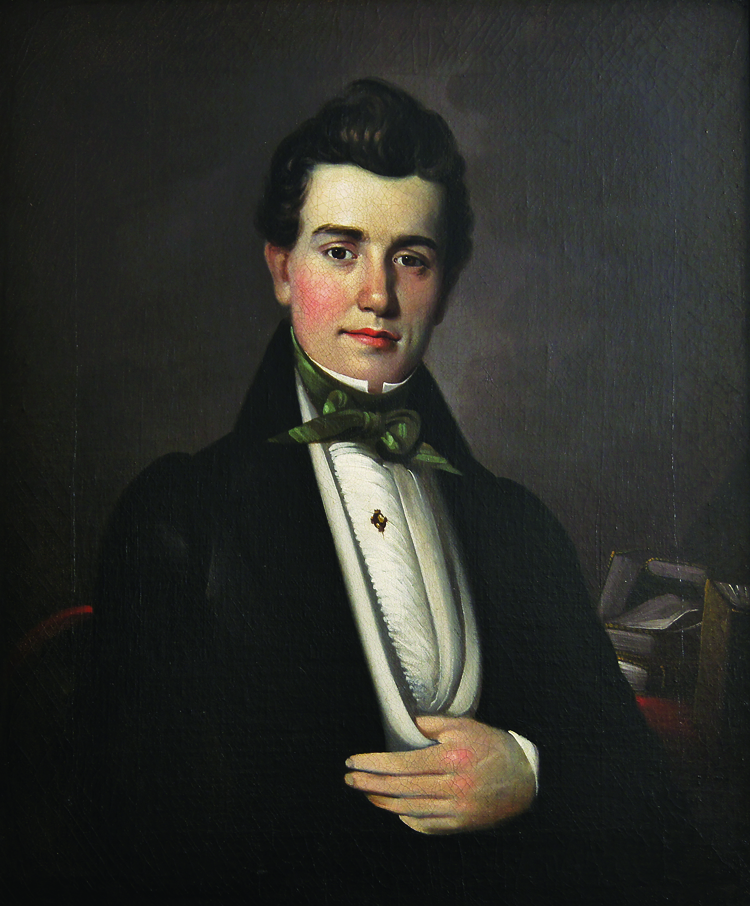William Matthew Prior
Artist, Businessman, & Visionary
For William Matthew Prior, art was a business. While living in Portland, Maine, in the 1820s, he received some sort of art instruction that enabled him to paint in a manner that approached an academic model. From his earliest work in the 1820s until his final efforts in the early-1870s, he adapted his painting style to respond to the economic variables that affected his clientele. He created “short hand” methods of taking likenesses for many who could not afford—or did not desire—his more sophisticated examples. Prior’s decorative paintings appealed to a solidly middle-class taste and, after an early venture into the world of the art establishment in Boston, he viewed himself as an artisan, not a fine artist. He actively responded to the social issues of his time and his religious beliefs added a significant dimension to his life and work. Unlike most of his contemporaries, he never had to pursue another occupation to support his large family and he remained a painter throughout his life. Prior’s mastery of his craft—and his pragmatic marketing strategy—made art available to a previously overlooked group of Americans.
William Matthew Prior was born May 16, 1806, in Bath, Maine, the fourth child of Captain Matthew (1774–1815) and Esther Bryant Prior (1781–1842). The extent of Prior’s early schooling is unknown, but the town of Bath, called the “city of ships,” was unusually cosmopolitan for a relatively rural outpost. Foreign crews and passengers were frequent visitors, offering the local populace first-hand accounts of exotic cultures and giving residents a broad awareness of world events. By the time Prior left in 1824 to seek his fortune in Portland, he had been exposed to more of the ways of the world than many eighteen-year-old men of his time.
Early records indicate that Prior first affiliated himself with Portland’s foremost house painter and his future father-in-law, Almery Hamblin (1776–1830), but soon aspired to a “higher” branch of artistic endeavor, that of portrait making. His first documented likeness is signed “Painted in C. Codmans Shop/Portland, Maine” (see Woman of 1824). Codman (ca. 1800–1842), was the city’s first professional ornamental and decorative painter and, through his association, Prior encountered a number of artists who would affect his career and seem to have pointed him to avenues that would lead directly to Boston. Recently discovered primary sources indicate a close association between Prior, Codman, Boston ornamental painter John Ritto Penniman (1782–1841), and the most notable portrait painter of the day, Gilbert Stuart (1755–1828).1 Tradition has long stated that Prior had been influenced by, trained with in some manner, or had at least observed the master portraitist; the direct link provided by Codman and Penniman make this a distinct possibility, and new information found in a contemporary letter, suggests that Prior knew all of these painters.2
Pior returned to Bath in mid-1827 and advertised as an ornamental painter, offering portrait painting and a sliding scale of fees that would characterize his work throughout his career: “PERSONS wishing for a flat Picture can have a Likeness without shade or shadow, at quarter price.” He returned to Portland in the early 1830s and continued to paint portraits throughout the decade. In 1840, he and his family moved to Boston, and in 1842, settled in East Boston, a working-class neighborhood of merchants and tradesmen. The decision to relocate appears to have been based on business considerations, rather than fine art aspirations. After the early-1840s, Prior viewed himself as an artisan or mechanic and never again made attempts to compete with the fine art “establishment.”
In the early-1840s; a religious movement founded by William Miller (1782–1849) a charismatic preacher from upstate New York, attracted Prior’s attention and changed his life forever. Miller, whose teachings became the basis of Millerism (now known as Adventism), was considered by some to be a prophet of doom, predicting that the world would end sometime between March 1843 and March 1844. An avid follower, Prior was commissioned to create images of the preacher and a descriptive chart that was used extensively in books and lectures. When the end of the world did not occur, the group divided, but Prior continued to believe in Miller’s prophecies.
After 1844, Prior was less active in Millerism and concentrated on expanding his painting business. He built a home and studio at 36 Trenton Street, East Boston, where his business flourished. The mid-1840s to 1850s saw a dramatic increase in children’s portraits—undoubtedly based on another business decision. He had to adjust his style to compete with the just-introduced—and immensely popular—medium of daguerreotypy, the first practical photographic process. He also drew on his skills as an ornamental painter and in the 1850s, responding to the demand for decorative pictures, began to produce landscapes and fanciful scenes derived from prints of the day or from his own imagination. He also mass-produced likenesses of famous Americans painted on glass, which he sold for about $8.00 apiece. Despite this lucrative sideline, he always listed himself as a “portrait painter” in the Boston city directories.
Prior’s beliefs in Millerism resurfaced in the 1860s and, remarkably for a man without a formal education, he authored two books that record his egalitarian beliefs and provide an account of his experiences with William Miller: The King’s Vesture (1862) and The Empyrean Canopy (1868). It is clear that Prior abhorred slavery, and, like other Evangelical reformers, felt that slavery was a sin against God. It is apparent that his sympathies lay with the Abolitionists although extensive research has found no documentary evidence of his active participation in any area of the movement. Judging by his documented portraits of African-Americans, he used his art to promote the visibility of the Abolitionist cause by depicting his sitters in a sensitive and respectful manner.
Prior died of typhoid fever in East Boston at age sixty-six in January 1873 and is buried in Woodlawn Cemetery, Everett, Massachusetts; on his gravestone are carved an artist’s palette and brushes. An obituary in his hometown paper, the Bath Daily Times, stated only, “Died in East Boston, Mr. William M. Prior, portrait painter, formerly of this city, aged 66.” It was little notice for the man who democratized American painting.
The first exhibition devoted solely to this American folk artist, Artist and Visionary: William Matthew Prior Revealed, is on view at the Fenimore Art Museum, Cooperstown, New York, through December 31, 2012. It’s then on view at The American Folk Art Museum, NYC, January 24–May 27, 2013. A catalogue, from which this article is adapted, is available. Funding was provided by The Henry Luce Foundation, the American Folk Art Society, and the Beryl P. Haas Charitable Remainder Unitrust. For more information call 607.547.1400 or visit www.fenimoreartmuseum.org.

- William Matthew Prior (1806–1873)
Charles E. and Octavia C. Adams, probably East Boston, Mass., 1848
On verso: Charles E Adams and Octavia C Adams/Age 3 years/by Wm M Prior 1848/aged 15 months.”
Oil on cardboard, 17 x 23 inches
Courtesy, Fenimore Art Museum, Cooperstown, N.Y.
The artist skillfully captured the personalities of siblings Charles E. (1844–1850) and Octavia C. (1847–ca. 1910) Adams, children of a blacksmith from East Boston. Thickly applied paint and loose brushwork suggest that Prior executed the portrait rapidly but took great care to delineate the sitters’ cherubic faces. At the time, Prior advertised that he could complete “flat” portraits in about one and a half hours. Details in costumes and props, such as Octavia’s coral necklace and bracelet (thought to ward off evil) and Charles’ whip, appear in both folk and academic portraits of the period.

- William Matthew Prior (1806–1873)
Three Sisters of the Copeland Family, East Boston, Mass., 1854
On verso: “W M Prior/36 Trenton Street (third section) East Boston/Sept 1854.”
Oil on canvas, 26⅞ x 36½ inches
Courtesy, Museum of Fine Arts, Boston. Bequest of Martha C. Karolik for the M. and M. Karolik. Collection of American Paintings, 1815–1865 (48.467).
When used-clothing dealer Samuel Copeland of Boston commissioned William Matthew Prior to paint his daughters’ portrait in 1854, he not only obtained a visual record of his family, he established them as decidedly middle-class. The large size of the picture, with its three figures carefully rendered, made this one of Prior’s more expensive works. As early as the 1830s, Prior advertised that a painting with full-length standing or sitting figures, with ornamental background, could be had for $25, and he offered a discount when the group included four or six children. Assuming that he increased his fees over the years, the Copeland portrait would have been at the top of his price scale. The Copeland sisters—six-year-old Eliza; four-year-old Margaret; and Nellie, almost two—are dressed in stylish clothing and accessories that reflect their father’s success. The props—a book, a nosegay of flowers, and a basket of cherries—allude to their education, beauty, and sweet disposition. Prior also painted their brother, James, and may have pictured the entire family. It is likely that Samuel Copeland became acquainted with Prior through William Lawson, his business neighbor. Both clothing dealers were located in part of the commercial marketplace near Faneuil Hall, which housed a variety of merchants and tradesmen.
Jacquelyn Oak is the manager of photographic rights and reproductions at the Shelburne Museum in Vermont, where she also teaches classes in American folk art. She is currently preparing a catalogue raisonne of the paintings of folk artists M. W. Hopkins and Noah North.
2. A letter (May 24, 1827) to Prior, owned by his great-great-great-great-granddaughter, written by Portland artist Joseph Titcomb Harris (1810-after 1870), an apprentice from Penniman’s studio in Boston, describes work that both he and Prior had done there. Harris also relates that another artist, James Frothingham (1786-1864), one of Stuart’s prize students, “….has a good opinion of your [Prior’s] works….” See Jacquelyn Oak and Gwendolyn DuBois Shaw, Artist and Visionary William Matthew Prior Revealed. (Cooperstown, New York: Fenimore Art Museum, 2012), 55.








































